One of the signs of a healthy plant is its vibrant and rich leaf color. Changes in hue or deformations in the leaf blade often indicate improper care, but more commonly, they signal disease or pest activity.
We’ll explain why currant leaves turn yellow in June and what to do about it — whether to use chemical treatments immediately or rely on natural remedies.
Table of contents
Yellowing Leaves Due to Drought in June
Early leaf yellowing can be caused by various factors, including weather conditions (sudden temperature fluctuations, prolonged rainfall, etc.).
Below, we’ll discuss other causes — those that gardeners can address themselves.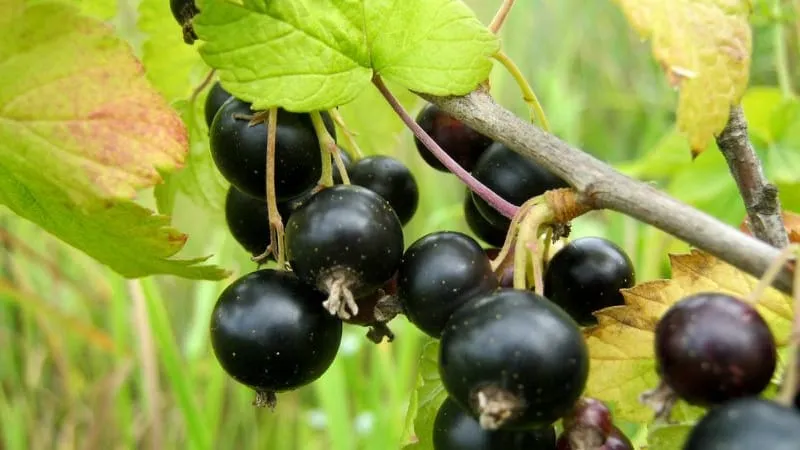
Nutrient Deficiency or Excess
Currant leaves often yellow and dry out due to improper fertilization. You can identify a deficiency or excess of specific elements by observing leaf changes:
- Magnesium. Yellowing of lower leaves indicates a magnesium deficiency. The veins remain green while the leaf blade yellows. Correct this by applying dolomite lime, wood ash, or magnesium sulfate.
- Potassium. Potassium deficiency causes yellowing along leaf edges, while the blade and veins stay green. Replenish potassium with potassium sulfate, potassium chloride, or potassium-magnesium sulfate. If leaves curl downward but don’t fall off, it suggests excess potassium.
- Nitrogen. Nitrogen deficiency leads to thin, elongated shoots and premature leaf drop. The leaf blade loses color, leaving only green veins. Fix this with mineral (urea, calcium nitrate, ammonium nitrate) or organic (poultry manure, cow/horse manure) nitrogen sources. Excess nitrogen makes leaves brittle and dark green.
- Iron. Iron deficiency causes yellowing and dry leaf edges. Apply iron sulfate to the roots and iron chelate as a foliar spray. Excess iron results in wilted leaves with pale veins.
Annual potassium requirements for young bushes are 30 g, phosphorus — 40 g.
Insufficient or Excessive Watering
Both underwatering and overwatering harm plants. Prolonged drought and inadequate watering lead to yellow leaves.
However, constant moisture causes root rot. Follow watering guidelines: 1–2 buckets of settled water per bush, moistening soil to 40–60 cm deep. Water every two weeks.
Poor Soil Aeration and Incorrect Planting
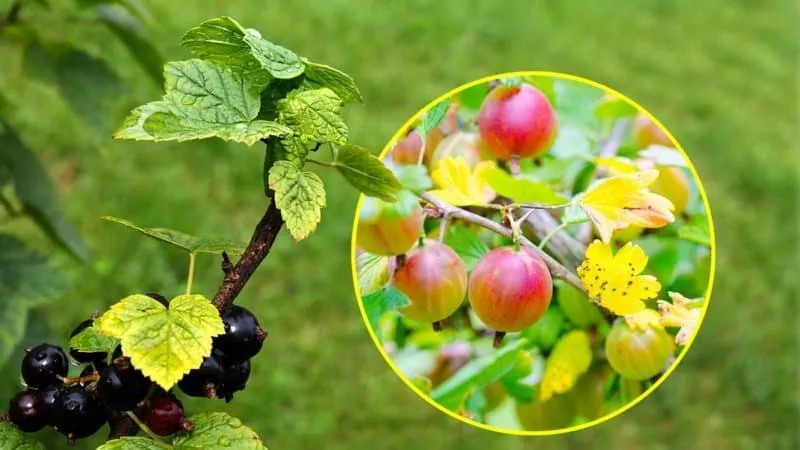
To maintain proper soil moisture, keep the ground loose and free of crust. Loosen soil every 15–20 days — up to 8 cm deep near bushes and 12 cm between rows.
Root and foliage development are closely linked. Planting depth and timing affect plant health. Planting before late frosts leads to yellow leaves and low survival rates. For best results, plant currants in autumn and insulate with burlap or agrofabric.
Shallow planting holes hinder root growth. Dig deeper holes to avoid this issue.
Note. Bushes may yellow due to age — after 15 years or more.
Pests and Plant Diseases
While the above issues are easily fixed, diseases or pests require more effort.
Yellowing currant leaves may indicate these diseases:
- Rust. Appears as yellow-orange bumps on leaf undersides or small reddish spots. Leaves and berries eventually dry and fall.
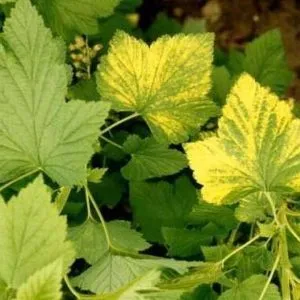
- Anthracnose. Circular brown spots merge into yellow patches. Yellowing indicates advanced disease.
- Mosaic. Pale yellow spots signal a viral infection. Leaves eventually turn fully yellow, with white, dried tissue between veins.
- Verticillium wilt. Stunted growth and yellowing lower leaves indicate nutrient deprivation due to root and vascular damage.
Powdery mildew (sphaerotheca) can also cause slight yellowing.
Remove yellowed leaves, dig up and burn severely infected plants, and treat with fungicides like Fitosporin-M or Agrolekar.
Pest Control Methods
Pests also cause yellowing leaves, with additional symptoms varying by insect type.
Inspect bushes carefully. Pest activity peaks during flowering and fruit formation.
Currant Aphids
Aphids damage currant leaves until mid-July before moving to other plants. In autumn, they lay eggs on branches, which hatch in spring.
Look for brown/yellow swellings on leaf tops. These darken as leaves dry. Tiny, translucent insects may be visible.
At first signs, douse bushes with boiling water. Many gardeners use this method pre-leaf emergence to destroy eggs.
Remove and burn mildly affected leaves (4–5). For heavily infested branches, prune and seal cuts with paint or grafting wax.
Note. Aphids prefer red/white currants over black varieties due to thinner leaves.
Natural Remedies
Boiling water treatment is common. Follow with lime washing to kill remaining eggs.
Other natural solutions:
- Baking soda spray. Mix 40 g grated soap in 10 L water, add 2 tbsp soda per liter. Apply in early spring before bud break.
- Soap solution. Dissolve 1.5 bars of grated soap in 2 L warm water, dilute to 10 L. Strain and spray.
- Celandine decoction. Steep 4 kg chopped celandine in 10 L water for 4–5 hours. Strain and spray.
Biological Treatments
For severe infestations, use biopesticides — safe for plants and humans during fruiting. Effective options:
- Actofit. Kills pests in 3–8 days. Mix 2 ml per 1 L water. Shake well before spraying.
- Fitoverm. Pests die within 2–3 days. Apply 2–3 times at 5–7 day intervals (2 ml per 1 L water).
Chemical Treatments
Chemicals act gradually. Reapply after rain. Harvest only 5+ days after spraying.
Use chemicals as a last resort. Recommended insecticides:
- Actellic. Fast-acting. Dosage: 1.5–2 ml per 1 L water. Two treatments, 5–7 days apart. Compatible with biopesticides.
- Biotlin. Budget alternative. Kills pests in 3–4 hours. Dilute concentrate in 0.5–1 L water first, then top up. Use 0.5–1.5 L per bush.
Wear protective gear when spraying. Avoid use during fruiting. Wait 20–30 days before harvesting.
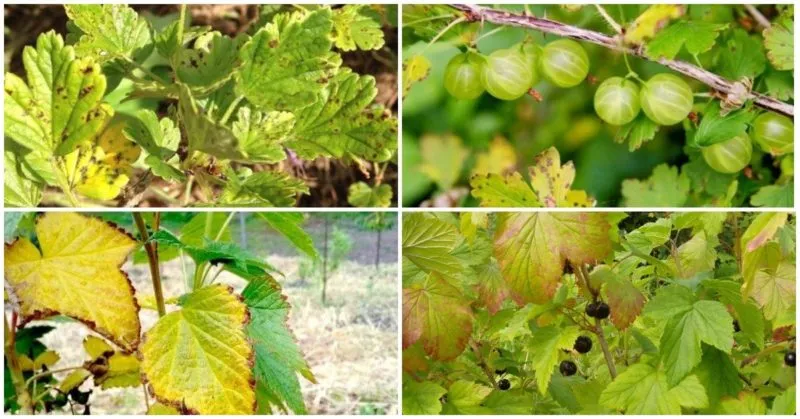
Currant Clearwing Moth
White caterpillars with black heads emerge in late June, burrowing into shoots. They target young black currant bushes, rarely others. Caterpillars tunnel downward, hollowing stems. Split stems reveal frass or larvae.
Infested shoots stop growing, dry out, and snap. Berries are scarce and sour. Larvae overwinter inside stems, requiring seasonal control.
Prune and burn dry shoots during growing season.
In early June, target adult moths. Reduce their numbers to limit larvae. Use Fitoverm Forte or Bitoxibacillin every 7–8 days on plants and soil.
Note. Moths appear in mid-June. Set sweet syrup traps near bushes. Treat plants after catching adults.
Chemical Treatments
Biopesticides work best preventively. For active infestations, use:
- Malathion. Apply 10% solution in early spring and post-flowering. Use 30 g per 4 L water (1–2 L per bush).
- Inta-Vir. Dissolve 1 tablet in 10 L water. Crush tablet in 300 ml water first, then dilute.
Also treat nearby raspberries — moths favor their pollen.
If unsuccessful, remove and burn severely infested bushes.
Natural Methods
These deter adult moths. No home remedies kill larvae.
Hang gasoline-soaked rags on bushes to mask currant scent. Use yellow/red cardboard traps over jars of molasses.
Spider Mites
Fine webbing, yellowing leaves, and stunted growth signal spider mites. Tiny and hard to spot, they start on lower leaves. Check undersides for larvae/adults. Peak reproduction occurs in late spring.
Chemical Treatments
Spider mites are arachnids, not insects — insecticides won’t work. Use acaricides or insectoacaricides. Two seasonal treatments suffice (avoid flowering periods).
Warning! Apply chemicals in dry, calm weather with protective gear.
Effective products:
- STOP Mite. Kills all life stages instantly. Long-lasting protection. Dosage: 7 ml per 5–6 L water.
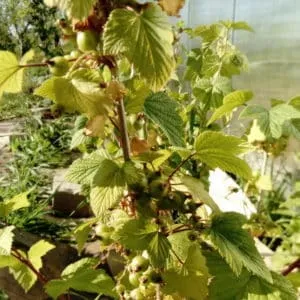
- Envidor. Works on all stages. Rain-resistant. Use 2–3 ml per 5 L water, twice per season (stop 20 days pre-harvest).
- Sanmite. Also controls other pests. Best applied during flowering. One treatment per season (5 g per 5 L water).
Biological Treatments
Effective biopesticides:
- Bitoxibacillin. Most effective against larvae. Use 80–100 g per 10 L water. Stop 5 days pre-harvest.
- Phytoseiulus. Contains predatory mites that eat spider mites. Release 20–50 per m² biweekly.
Natural Remedies
Repellent sprays:
- Garlic extract. Soak 5 crushed cloves in 1 L water for 10–12 hours. Dilute 1:1 and spray. Repeat after 3 weeks.
- Tobacco infusion. Steep 250 g tobacco in 2.5 L hot water for 24 hours. Strain, add 0.5 L water + 20 g soap.
- Herbal tea. Use calendula, wormwood, or celandine (100–120 g per 10 L hot water). Steep 2–3 hours, strain.
Colloidal sulfur or alcohol-water sprays also suppress mites.
Preventive Measures
Autumn prevention disrupts pest life cycles:
- Treat infested bushes with insecticides in autumn. Spring preventive spraying is also possible pre-bud break.
- Prune sanitarily — remove crowded, diseased, or weak stems. Seal cuts with grafting wax.
- Water deeply post-leaf fall, loosen soil gently, and mulch with ash/mustard/pepper.
- Collect and burn yellowed leaves.
- Plant strong-smelling herbs nearby — garlic, onions, marigolds.
Avoid bark damage during maintenance.
Conclusion
Pests often appear during growth periods but go unnoticed until leaves yellow. Regular inspections prevent outbreaks. Biopesticides usually suffice — they’re non-toxic and human-safe.







